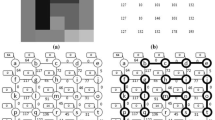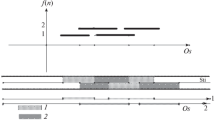Abstract
In this paper the implementation of a parallel watershed algorithm is described. The algorithm has been implemented on a Cray J932, which is a shared memory architecture with 32 processors. The watershed transform has generally been considered to be inherently sequential, but recently a few research groups, see [5, 9, 10], have designed parallel algorithms for computing watersheds. Most of these parallel algorithms are based on splitting the source image in blocks, computing the watersheds of these blocks and merging the resulting images into the desired result. A disadvantage of this approach is that a lot of communication is necessary at the boundaries of the blocks. It is possible to formulate the computation of the watershed transform as a shortest path searching problem that is commonly found in algorithmic graph theory. In this paper we use a parallel adapted version of Dijkstra’s algorithm for computing shortest paths in undirected graphs.
Access this chapter
Tax calculation will be finalised at checkout
Purchases are for personal use only
Preview
Unable to display preview. Download preview PDF.
Similar content being viewed by others
References
E.W. Dijkstra. A Note on Two Problems in Connexion with Graphs, In Numerische Mathematik 1, pp.269–271, 1959
E.W. Dijkstra. Co-operating Sequential Processes. In F. Genuys (ed.), Programming Languages, Academic Press, London, 1968, pp.43–112
S. Beucher and F. Meyer. The morphological approach to segmentation: The watershed transformation. In E.R. Dougherty, editor, Mathematical Morphology in Image Processing. Marcel Dekker, New York, 1993. Chapter 12, pp. 433–481.
J.A. McHugh. Algorithmic Graph Theory, Prentice-Hall, 1990.
A. Meijster and J.B.T.M. Roerdink. A Proposal for the Implementation of a Parallel Watershed Algorithm. In Proceedings Computer Analysis of Images and Patterns (CAIP’95), Springer Verlag, 1995, pp. 790–795.
F. Meyer and S. Beucher. Morphological segmentation. Journal of Visual Communications and Image Representation, 1(1):21–45, 1990.
F. Meyer. Integrals, gradients and watershed lines. In J. Serra and P. Salembier (Eds.), Proc. Workshop on Mathematical Morphology and its Applications to Signal Processing, Barcelona, 1993, pp. 70–75.
F. Meyer. Minimum spanning forests for morphological segmentation. In Mathematical Morphology and its Applications to Image Processing, J. Serra, P. Soille (eds.), Kluwer, 1994, pp. 77–84.
A.N. Moga, T. Viero, B.P. Dobrin, M. Gabbouj. Implementation of a distributed watershed algorithm. In J. Serra and P. Soille (Eds.), Mathematical Morphology and Its Applications to Image Processing, Kluwer, 1994, pp. 281–288.
A.N. Moga, T. Viero, M. Gabbouj. Parallel Watershed Algorithm Based on Sequential Scanning. In I. Pitas (Ed.), 1995 IEEE Workshop on Nonlinear Signal and Image Processing, June 20–22, Neos Marmaras, Halkidiki, Greece, pp. 991–994.
L. Vincent and P. Soille, Watersheds in Digital Spaces: An Efficient Algorithm Based on Immersion Simulations. IEEE Transactions on Pattern Analysis and Machine Intelligence, 13, no. 6, pp 583–598, June 1991.
Author information
Authors and Affiliations
Editor information
Editors and Affiliations
Rights and permissions
Copyright information
© 1996 Kluwer Academic Publishers
About this chapter
Cite this chapter
Meijster, A., Roerdink, J.B.T.M. (1996). Computation of Watersheds Based on Parallel Graph Algorithms. In: Maragos, P., Schafer, R.W., Butt, M.A. (eds) Mathematical Morphology and its Applications to Image and Signal Processing. Computational Imaging and Vision, vol 5. Springer, Boston, MA. https://doi.org/10.1007/978-1-4613-0469-2_35
Download citation
DOI: https://doi.org/10.1007/978-1-4613-0469-2_35
Publisher Name: Springer, Boston, MA
Print ISBN: 978-1-4613-8063-4
Online ISBN: 978-1-4613-0469-2
eBook Packages: Springer Book Archive




